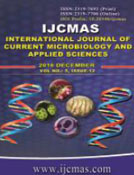


 National Academy of Agricultural Sciences (NAAS)
National Academy of Agricultural Sciences (NAAS)

|
PRINT ISSN : 2319-7692
Online ISSN : 2319-7706 Issues : 12 per year Publisher : Excellent Publishers Email : editorijcmas@gmail.com / submit@ijcmas.com Editor-in-chief: Dr.M.Prakash Index Copernicus ICV 2018: 95.39 NAAS RATING 2020: 5.38 |
Marine algae living in the intertidal zone must endure changes in temperature, wave action, salinity and moisture, which become more intense as height increases. Species diversity declines with height above sea level, as fewer species can tolerate these increasingly harsh conditions. The vertical distribution of Grateloupia filicina, and species composition along with associated fauna were examined on from August 2013 to July 2014. This study demonstrates a rapid increase in the growth parameters from January onwards and attaining maximum growth in April/May. Also a significant negative correlation between the biomass and height above sea level was observed. There are indications that types of algae particularly the foliose and the encrusting species generally occupy different areas in the intertidal zone. The seaweed showed different tolerance response to environmental parameters and nutrient levels. Maximum numbers of associated fauna (density) was recorded in the mid tidal zone when compared to low and high inter tidal zone. The limited number of species and simple community structure may be due to the pollution and ditophiisturbance of macroalgal habitats by human activities.
 |
 |
 |
 |
 |